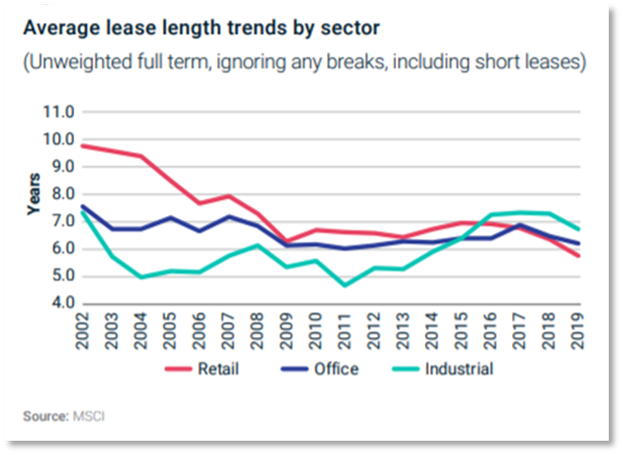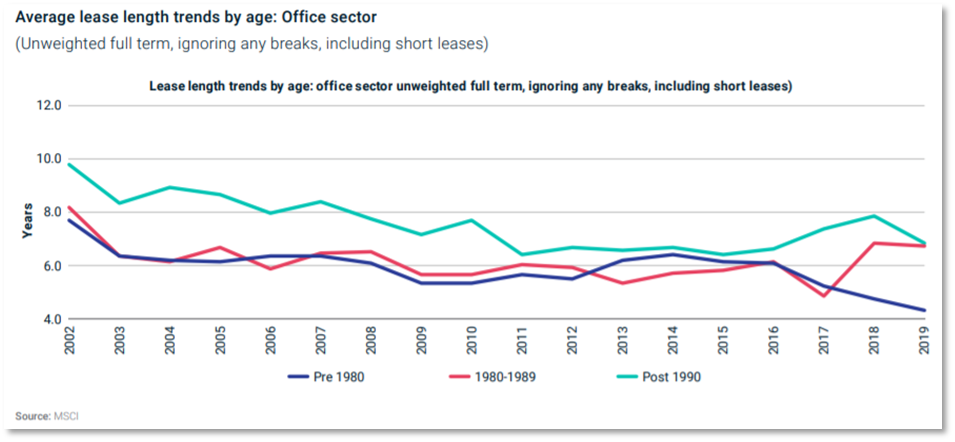- 4 Minute Read
- 15th December 2021
Is this the end of the long-term office lease?
As 2021 draws towards a close, there is increasing evidence that market conditions are shortening the length of the average office lease. In the 1970s and 80s average lease lengths of c.15 years were not uncommon, but a largely downward trend since then has pushed average office lease durations down to around six years as of today.
In this article we will look at how and why lease durations have changed in recent times, the impacts of the pandemic on office leasing and the advantages and disadvantages of taking short and long-term office leases.

According to data from MSCI, all commercial leases are shorter than they were in 2002. In 2002 the average office lease length was 7.5 years, but now sits at around six years. Office lease durations dipped after the global financial crash in 2007/8 but started to lengthen again in 2016. From 2017 the downward trend resumed, a clear indicator of uncertainty in the market and the push for more flexibility.

Analysing office lease lengths by the age of the building shows that office property constructed before 1980 has seen lease lengths shorten the most. These have all but halved, from just under eight years in 2002 to four years in 2019. Newer office property (built after 1990) tends to attract longer lease agreements, implying that larger occupiers are more likely to commit to longer leases in newer properties.
The pandemic has increased demand for greater flexibility
The advent of COVID-19 put huge short-term pressures on the global office market. Repeated lockdowns, work from home mandates and an accelerated shift towards flexible working, all meant that businesses the world over were forced to rethink their commitment to long-term office leases.
In the UK, the pandemic introduced another dynamic into the landlord/tenant relationship, already under pressure from Brexit. According to data collected by BNP Paribas, what impacts lease lengths more significantly than anything else is uncertainty.
The trend towards shorter leases reflects the demand for greater flexibility and the caution being exercised by businesses nervous about making long-term commitments in the age of COVID-19. Benn Munn, Global Flex Space Lead JLL commented “…corporations will continue to pursue office space options that provide them with enhanced flexibility for the foreseeable future … whittling down lease terms is part of that effort.”
Controlling costs and increasing agility are key
Many companies that had not incorporated flexible office strategies into their real estate portfolio prior to the pandemic are now looking to do so in order to develop a more fluid portfolio, complementing the shift towards shorter length leases. Flexible workspaces, including serviced offices, coworking spaces and hotdesking, are being used in a wide variety of ways by corporations. Some seek to reduce overheads by taking space on demand, adopting hub and spoke strategies or utilising coworking options as a third workplace. For many, agility is the key, having the flexibility to expand or contract space in line with variations in headcount and with minimum hassle and expense.
A mix of traditional and flexible workspace is becoming more popular within commercial real estate portfolios as companies try to optimise the blend of productive, innovative, and collaborative space, whilst balancing their financial and strategic objectives.
Short-term office leases vs long-term office leases
The main decision facing business owners looking to lease office space is whether to lease long-term or short-term. For this purpose, we’ve defined a lease under 10 years duration as short-term. Both options present advantages and disadvantages depending upon the needs of the business.
Advantages of a short-term office lease

In a short-term office lease, the business isn’t tied in for too long, so this provides a degree of flexibility should circumstances change. In general, the tenant has fewer responsibilities for issues such as maintenance and expansion will be that bit easier when bigger or better space is required. For tenants and landlords there are advantages around the speed at which deals can be done. Landlords may have to forgo the certainty of long-term rental income but will be able to revisit lease terms once the market settles.
Disadvantages of a short-term office lease

Rental rates for short-term leases are generally higher than those for longer-term lease. The landlord may also choose to increase rents each time the lease is up for renewal. If the landlord has no desire to renew the lease, then the tenant can invest a lot of time and money looking for new premises.
Advantages of a long-term office lease
In a long-term lease the tenant is protected from frequent rent increases, this provides financial certainty. Overheads can be minimised, as the rental rate will usually be lower than that within a short-term lease. The working environment can also be crafted by the tenant to their exact specification and a business can build a strong client base and talent pool when it is in the same location for a long time. Consequently, the costs of seeking new premises can be avoided for many years.
Disadvantages of a long-term office lease
Long-term leases are inflexible. In a long-term lease the business is saddled with the office even if it is not suitable or performing well in that location. Whilst rents are generally lower in a long-term lease, there is no guarantee that market rates will not fall, leading to much lower market prices and the tenant being stuck on a higher rate. The inflexibility of a long-term lease means that expanding or contracting space may be difficult (if not impossible) and extra expense will be incurred.
The future is flexible

When drastic events, such as the financial crash and the pandemic hit markets, the disadvantages of a long-term lease really hit home. Nobody wants to be stuck with expensive vacant office space long-term, so in times of uncertainty, flexibility really is your friend.
Flexible workspaces are providing a lifeline for companies seeking affordable flexible office solutions. Flex offices are widely available the world over and the offices are fully equipped and serviced. Most are packed with amenities and are ready to occupy the next day. The all-inclusive pricing makes budgeting easy and the flexibility to expand or contract space as required is a significant advantage. The simplicity of flexible rental agreements also makes the procurement process much easier.
As the flexible workspace market evolves, traditional leasing looks more unattractive. Flexible workspace has become a credible, competitive alternative to conventional office leasing and looks set to take a greater share of office portfolios in years to come.
